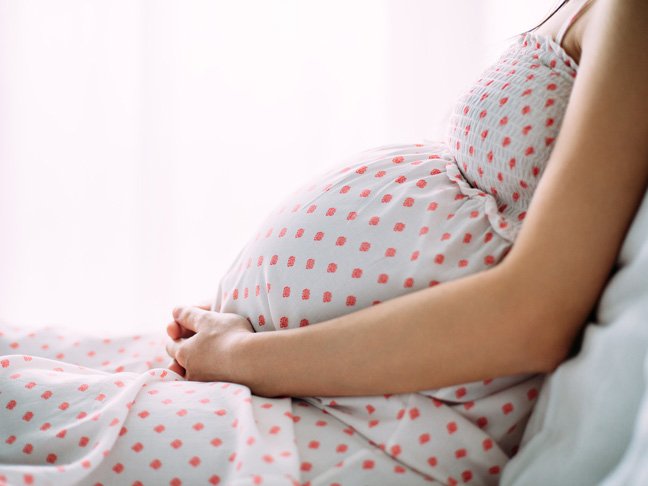Whether this is your first baby or your fourth, bleeding while pregnant can be really worrisome. Is it normal to bleed during pregnancy? Well, yes and no. Bleeding during early pregnancy is very common and most often harmless, according to WebMD. Later on though, bleeding during pregnancy could indicate a more serious problem.
If you are bleeding during pregnancy, whether it’s the first trimester or your third, the American Pregnancy Association (APA) suggests wearing a pad or panty liner to monitor the blood flow — both the amount and the consistency. Avoid obstructing the vaginal canal with a tampon or douche, and abstain from intercourse until you’ve spoken with your doctor.
Of course, knowledge is power, so we’ve identified some common causes of bleeding during pregnancy, both early on and during the second and third trimester, when the causes of bleeding during pregnancy tend to be more serious.
Bleeding During Pregnancy: First Trimester
According to the American Pregnancy Association, about 20 to 30 percent of women experience some sort of bleeding during the first trimester. Some common causes are:
1. Implantation bleeding
About 10 days to 2 weeks following ovulation, about 1/3 of women will experience implantation bleeding, which occurs when an embryo attaches itself to the uterine wall. It’s usually very light and lasts anywhere from a few hours to a couple of days.
2. Miscarriage
If you’re experiencing bleeding during the first trimester, your main concern might be that you’re having a miscarriage, especially since it most often happens within the first 12 weeks of pregnancy. The good news is that half of women who bleed during pregnancy do not have miscarriages, according to the APA. And over 90 percent of women who have vaginal bleeding, will not miscarry if they’ve seen a heartbeat on the ultrasound, says WebMD. That being said, the APA estimates that about 15 to 20 percent of pregnancies result in miscarriage, so if you’re experiencing strong cramps in the lower stomach, and see tissue passing in the blood, call your doctor ASAP.
3. Cervical changes
During pregnancy, your cervix is particularly sensitive because extra blood is flowing to that area. This can cause bleeding after sex while pregnant. While it’s not cause for concern, you will want to hold off on intercourse until you’ve been seen by a doctor, the APA recommends.
4. Infection
If you have irritation down below, along with bleeding, an infection or a sexually transmitted disease (like chlamydia, gonorrhea, or herpes) could be to blame, according to WebMD.
5. Ectopic pregnancy
Although rare, only occurring in about 1 out of 60 pregnancies, ectopic pregnancies are life-threatening and need to be treated right away. An ectopic pregnancy happens when a fertilized embryo implants itself outside of the uterus, most often in the fallopian tube. You may experience sharp pain in the lower stomach or strong cramps, and might also be lightheaded. According to the APA, mothers are at higher risk if they’ve had an infection in their fallopian tubes, pelvic surgery, or a previous ectopic pregnancy.
6. Molar pregnancy
Even more rare are molar pregnancies, which are the growth of abnormal tissues in the uterus, and not an actual embryo. Your doctor can identify a molar pregnancy on an ultrasound and while it’s not a viable pregnancy, it poses no risks to the mom. A molar pregnancy often terminates on its own (you will likely miscarry), or you may need a D&C, also known as dilation and curettage, which is a surgical procedure in which the cervix is opened to remove the contents of the uterus.
Bleeding During Pregnancy: Second & Third Trimesters
Bleeding later on in a pregnancy is always cause for concern, so if you experience any bleeding in the second or third trimester, you’ll want to call your doctor right away. Some possible causes at this stage are:
1. Premature labor
If you’re nearing your due date, vaginal bleeding could simply indicate that your body is gearing up to give birth. Days or even weeks before labor, your mucus plug will pass through the vagina, often containing small amounts of blood. It’s usually just your body’s way of getting ready to push out that baby, but if it’s before your 37th week of pregnancy, and is accompanied by contractions and lower back ache, you could be going into premature labor.
2. Placental abruption
If you’re having abdominal pain, clots, and back pain, this could be a sign of a placental abruption, which occurs in about 1 percent of pregnancies. This happens when the placenta detaches from the uterine wall. Women who are older than 35, have high blood pressure, or have had trauma to their stomach are at higher risk, according to the APA. It poses a threat to both mom and baby, so you’ll want to seek medical attention immediately.
3. Placenta previa
An extremely rare condition, occurring in just one out of 200 pregnancies, placenta previa is when the placenta is partially or completely covering the birth canal. There is usually no pain, but if you’re bleeding, you will need to see your doctor right away. If you’ve already had children, had a previous cesarean birth, or are carrying multiples, you are at higher risk of developing placenta previa.
4. Uterine rupture
According to WebMD, if you’ve had a previous C-section, that scar can tear during pregnancy, putting you and baby at risk, and requiring an emergency C-section.
5. Vasa previa
If your baby’s blood vessels in the umbilical cord or placenta cross the opening to the birth canal, there is a risk they can tear open and cause blood loss to the baby. This too is an extremely rare condition.
As we said, any bleeding during the second and third trimester warrants a call to your doctor, but you’ll want to go straight to the ER if you’re having severe pain or bleeding, if you have a fever or chills, if you’re dizzy, or if there is tissue passing through in your blood.
Photo: Getty








